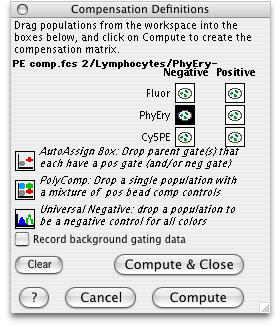

# collapseDataForGating groupBy preprocessing_method preprocessing_args We will try to explain how to create this gating template based on the manual gating scheme row by row.ĭtTemplate # alias pop parent dims gating_method gating_args # 3: K=2,target=c(1e5,5e4) NA NA prior_flowClustĮach row is usually corresponding to one cell population and the gating method that is used to get that population. # gating_args collapseDataForGating groupBy preprocessing_method # 8: CD45_neg - cd4+cd8- CD45RA gate_mindensity # 7: activated cd8 ++ cd4-cd8+ CD38,HLA tailgate # 6: activated cd4 ++ cd4+cd8- CD38,HLA tailgate # 3: lymph + singlets FSC-A,SSC-A flowClust # 2: singlets + nonDebris FSC-A,FSC-H singletGate # 1: nonDebris + root FSC-A gate_mindensity GtFile <- system.file( "extdata/gating_template/tcell.csv", package = "openCyto")ĭtTemplate # alias pop parent dims gating_method preprocessing_args: the named arguments passed to the preprocessing function.The preprocessing results are then passed to the appropriate gating wrapper function through its pps_res argument. It is invoked by a wrapper function that has the identical function name prefixed with a dot (e.g.prior_flowClust). preprocessing_method: the name of the preprocessing function (e.g.When this is numeric (N), samples are grouped by every N samples groupBy: If provided, samples are split into groups by the unique combinations of the named study variable (i.e. column names of pData, e.g.“PTID:VISITNO”).When set FALSE (or blank), the groupBy argument is only used by preprocessing and ignored by gating. collapseDataForGating: When TRUE, data is collapsed (within groups if groupBy is specified) before gating and the gate is replicated across collapsed samples.gating_args: the named arguments passed to the gating function.It is invoked by a wrapper function that has the identical function name prefixed with a dot.(e.g.flowClust) gating_method: the name of the gating function (e.g.These can be either channel names or stained marker names. dims: characters seperated by commas specifying the dimensions (1-D or 2-D) used for gating.parent: the parent population alias, whose path also has to be uniquely identifiable.pop: population patterns of +/- or +/-+/-, which tell the algorithm which side (postive or negative) of a 1-D gate or which quadrant of a 2-D gate are to be kept.alias: a name used to label the cell population, with the path composed of the alias and its precedent nodes (e.g. /root/A/B/alias) being uniquely identifiable.This spread sheet must have the following columns:

First of all, we need to describe the gating hierarchy in a spread sheet (a plain text format).


 0 kommentar(er)
0 kommentar(er)
